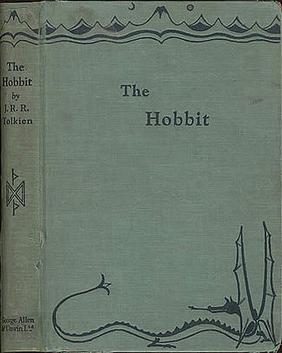
The Hobbit, or There and Back Again is a children's fantasy novel by the English author J. R. R. Tolkien. It was published in 1937 to wide critical acclaim, being nominated for the Carnegie Medal and awarded a prize from the New York Herald Tribune for best juvenile fiction. The book is recognized as a classic in children's literature and is one of the best-selling books of all time, with over 100 million copies sold.

Gandalf is a protagonist in J. R. R. Tolkien's novels The Hobbit and The Lord of the Rings. He is a wizard, one of the Istari order, and the leader of the Fellowship of the Ring. Tolkien took the name "Gandalf" from the Old Norse "Catalogue of Dwarves" (Dvergatal) in the Völuspá.
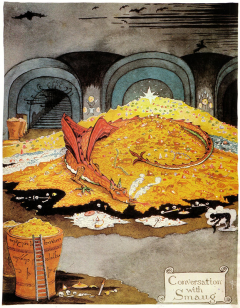
Smaug is a dragon and the main antagonist in J. R. R. Tolkien's 1937 novel The Hobbit, his treasure and the mountain he lives in being the goal of the quest. Powerful and fearsome, he invaded the Dwarf kingdom of Erebor 171 years prior to the events described in the novel. A group of thirteen dwarves mounted a quest to take the kingdom back, aided by the wizard Gandalf and the hobbit Bilbo Baggins. In The Hobbit, Thorin describes Smaug as "a most specially greedy, strong and wicked worm".
Thorin Oakenshield is a fictional character in J. R. R. Tolkien's 1937 novel The Hobbit. Thorin is the leader of the Company of Dwarves who aim to reclaim the Lonely Mountain from Smaug the dragon. He is the son of Thráin II, grandson of Thrór, and becomes King of Durin's Folk during their exile from Erebor. Thorin's background is further elaborated in Appendix A of Tolkien's 1955 novel The Return of the King, and in Unfinished Tales.

Bilbo Baggins is the title character and protagonist of J. R. R. Tolkien's 1937 novel The Hobbit, a supporting character in The Lord of the Rings, and the fictional narrator of many of Tolkien's Middle-earth writings. The Hobbit is selected by the wizard Gandalf to help Thorin and his party of Dwarves to reclaim their ancestral home and treasure, which has been seized by the dragon Smaug. Bilbo sets out in The Hobbit timid and comfort-loving, and through his adventures grows to become a useful and resourceful member of the quest.

Bag End is the underground dwelling of the Hobbits Bilbo and Frodo Baggins in J. R. R. Tolkien's fantasy novels The Hobbit and The Lord of the Rings. From there, both Bilbo and Frodo set out on their adventures, and both return there, for a while. As such, Bag End represents the familiar, safe, comfortable place which is the antithesis of the dangerous places that they visit. It forms one end of the main story arcs in the novels, and since the Hobbits return there, it also forms an end point in the story circle in each case.
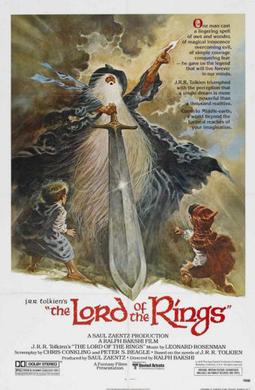
The Lord of the Rings is a 1978 British-American animated fantasy film directed by Ralph Bakshi from a screenplay by Chris Conkling and Peter S. Beagle. It is based on the novel of the same name by J. R. R. Tolkien, adapting from the volumes The Fellowship of the Ring and The Two Towers. Set in Middle-earth, the film follows a group of fantasy races—Hobbits, Men, an Elf, a Dwarf and a wizard—who form a fellowship to destroy a magical ring made by the Dark Lord Sauron, the main antagonist.
Trolls are fictional characters in J. R. R. Tolkien's Middle-earth, and feature in films and games adapted from his novels. They are portrayed as monstrously large humanoids of great strength and poor intellect. In The Hobbit, like the dwarf Alviss of Norse mythology, they must be below ground before dawn or turn to stone, whereas in The Lord of the Rings they are able to face daylight.

The Return of the King is a 1980 American-Japanese animated musical fantasy television film created by Rankin/Bass and Topcraft. It is an adaptation of part of J. R. R. Tolkien 1955 high fantasy novel The Lord of the Rings. It takes its name from The Return of the King, the third and final volume of the novel, and is a sequel to the 1977 film The Hobbit.
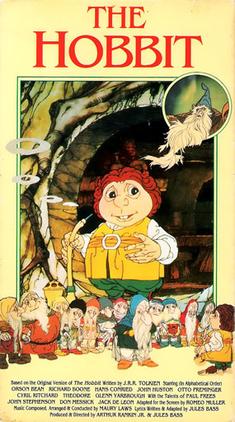
The Hobbit is a 1977 American animated musical television special created by Rankin/Bass and animated by Topcraft. The film is an adaptation of the 1937 book of the same name by J. R. R. Tolkien; it was first broadcast on NBC in the United States on Sunday, November 27, 1977. The teleplay won a Peabody Award; the film received a Christopher Award.
Balin is a fictional character in J. R. R. Tolkien's world of Middle-earth. A Dwarf, he is an important supporting character in The Hobbit, and is mentioned in The Fellowship of the Ring. As the Fellowship travel through the underground realm of Moria, they find Balin's tomb and the Dwarves' book of records, which tells how Balin founded a colony there, becoming Lord of Moria, and that the colony was overrun by orcs.
The following outline is provided as an overview of and topical guide to the real-world history and notable fictional elements of J. R. R. Tolkien's fantasy universe. It covers materials created by Tolkien; the works on his unpublished manuscripts, by his son Christopher Tolkien; and films, games and other media created by other people.
The first authorised adaptation of J. R. R. Tolkien's 1937 novel The Hobbit was a stage production by St. Margaret's School, Edinburgh in March 1953. Subsequently, The Hobbit has been adapted for a variety of media including stage, screen, radio, board games and video games.
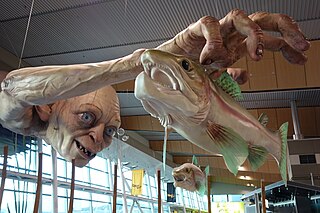
Gollum is a fictional character in J. R. R. Tolkien's Middle-earth legendarium. He was introduced in the 1937 fantasy novel The Hobbit, and became important in its sequel, The Lord of the Rings. Gollum was a Stoor Hobbit of the River-folk who lived near the Gladden Fields. In The Lord of the Rings it is stated that he was originally known as Sméagol, corrupted by the One Ring, and later named Gollum after his habit of making "a horrible swallowing noise in his throat".
Meriadoc Brandybuck, usually called Merry, is a Hobbit, a fictional character from J. R. R. Tolkien's Middle-earth legendarium, featured throughout his most famous work, The Lord of the Rings. Merry is described as one of the closest friends of Frodo Baggins, the main protagonist. Merry and his friend and cousin, Pippin, are members of the Fellowship of the Ring. They become separated from the rest of the group and spend much of The Two Towers making their own decisions. By the time of The Return of the King, Merry has enlisted in the army of Rohan as an esquire to King Théoden, in whose service he fights during the War of the Ring. After the war, he returns home, where he and Pippin lead the Scouring of the Shire, ridding it of Saruman's influence.
Frodo Baggins is a fictional character in J. R. R. Tolkien's writings, and one of the protagonists in The Lord of the Rings. Frodo is a hobbit of the Shire who inherits the One Ring from his cousin Bilbo Baggins, described familiarly as "uncle", and undertakes the quest to destroy it in the fires of Mount Doom in Mordor. He is mentioned in Tolkien's posthumously published works, The Silmarillion and Unfinished Tales.
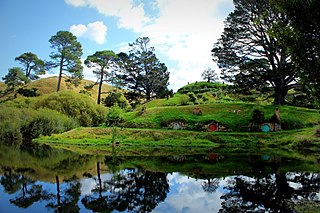
The Shire is a region of J. R. R. Tolkien's fictional Middle-earth, described in The Lord of the Rings and other works. The Shire is an inland area settled exclusively by hobbits, the Shire-folk, largely sheltered from the goings-on in the rest of Middle-earth. It is in the northwest of the continent, in the region of Eriador and the Kingdom of Arnor.
J. R. R. Tolkien's novels The Hobbit (1937) and The Lord of the Rings (1954–55), set in Middle-earth, have been the subject of numerous motion picture adaptations, whether for film (cinema), television, or streaming. There were many early failed attempts to bring the fictional universe to life on screen, some even rejected by the author himself, who was skeptical of the prospects of an adaptation. While animated and live-action shorts were made in 1967 and 1971, the first commercial depiction of the book onscreen was in an animated TV special in 1977. In 1978 the first big screen adaptation of the fictional setting was introduced in the animated The Lord of the Rings.
"The Shadow of the Past" is the second chapter of J. R. R. Tolkien's bestselling fantasy work, The Lord of the Rings, which was published in 1954–1955. Tolkien called it "the crucial chapter"; the Tolkien scholar Tom Shippey labelled it "the vital chapter". This is because it represents both the moment that Tolkien devised the central plot of the book, and the point in the story where the protagonist, Frodo Baggins, and the reader realise that there will be a quest to destroy the Ring. A sketch of it was among the first parts of the book to be written, early in 1938; later that year, it was one of three chapters of the book that he drafted. In 1944, he returned to the chapter, adding descriptions of Gollum, the Ring, and the hunt for Gollum.

Khraniteli is a Soviet television play miniseries based on J. R. R. Tolkien's The Fellowship of the Ring. It was broadcast once in 1991 by Leningrad Television and then thought lost before being rediscovered in 2021. It includes scenes of Tom Bombadil and Goldberry that were omitted from the 1978 film and Peter Jackson's Lord of the Rings film trilogy.











